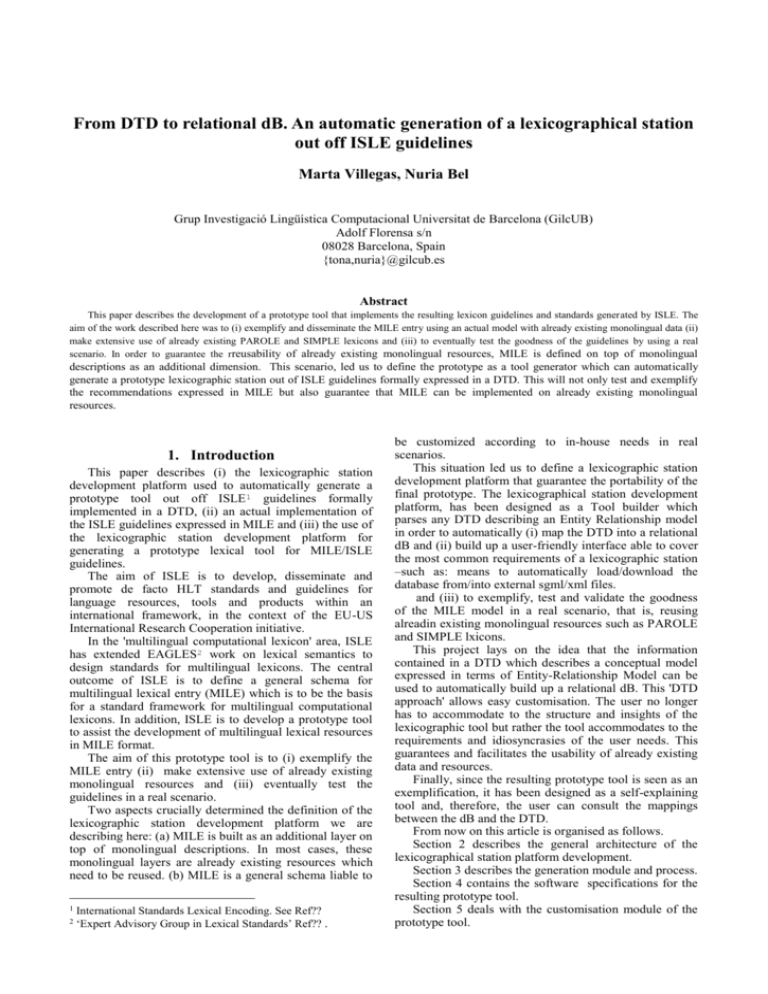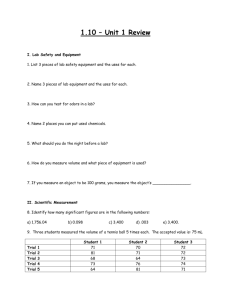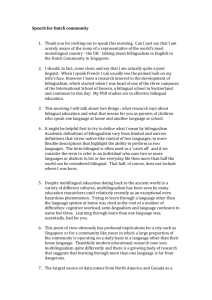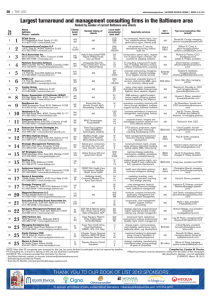Paper Title
advertisement

From DTD to relational dB. An automatic generation of a lexicographical station
out off ISLE guidelines
Marta Villegas, Nuria Bel
Grup Investigació Lingüística Computacional Universitat de Barcelona (GilcUB)
Adolf Florensa s/n
08028 Barcelona, Spain
{tona,nuria}@gilcub.es
Abstract
This paper describes the development of a prototype tool that implements the resulting lexicon guidelines and standards generated by ISLE. The
aim of the work described here was to (i) exemplify and disseminate the MILE entry using an actual model with already existing monolingual data (ii)
make extensive use of already existing PAROLE and SIMPLE lexicons and (iii) to eventually test the goodness of the guidelines by using a real
scenario. In order to guarantee the rreusability of already existing monolingual resources, MILE is defined on top of monolingual
descriptions as an additional dimension. This scenario, led us to define the prototype as a tool generator which can automatically
generate a prototype lexicographic station out of ISLE guidelines formally expressed in a DTD. This will not only test and exemplify
the recommendations expressed in MILE but also guarantee that MILE can be implemented on already existing monolingual
resources.
1. Introduction
This paper describes (i) the lexicographic station
development platform used to automatically generate a
prototype tool out off ISLE 1 guidelines formally
implemented in a DTD, (ii) an actual implementation of
the ISLE guidelines expressed in MILE and (iii) the use of
the lexicographic station development platform for
generating a prototype lexical tool for MILE/ISLE
guidelines.
The aim of ISLE is to develop, disseminate and
promote de facto HLT standards and guidelines for
language resources, tools and products within an
international framework, in the context of the EU-US
International Research Cooperation initiative.
In the 'multilingual computational lexicon' area, ISLE
has extended EAGLES2 work on lexical semantics to
design standards for multilingual lexicons. The central
outcome of ISLE is to define a general schema for
multilingual lexical entry (MILE) which is to be the basis
for a standard framework for multilingual computational
lexicons. In addition, ISLE is to develop a prototype tool
to assist the development of multilingual lexical resources
in MILE format.
The aim of this prototype tool is to (i) exemplify the
MILE entry (ii) make extensive use of already existing
monolingual resources and (iii) eventually test the
guidelines in a real scenario.
Two aspects crucially determined the definition of the
lexicographic station development platform we are
describing here: (a) MILE is built as an additional layer on
top of monolingual descriptions. In most cases, these
monolingual layers are already existing resources which
need to be reused. (b) MILE is a general schema liable to
1
2
International Standards Lexical Encoding. See Ref??
‘Expert Advisory Group in Lexical Standards’ Ref?? .
be customized according to in-house needs in real
scenarios.
This situation led us to define a lexicographic station
development platform that guarantee the portability of the
final prototype. The lexicographical station development
platform, has been designed as a Tool builder which
parses any DTD describing an Entity Relationship model
in order to automatically (i) map the DTD into a relational
dB and (ii) build up a user-friendly interface able to cover
the most common requirements of a lexicographic station
–such as: means to automatically load/download the
database from/into external sgml/xml files.
and (iii) to exemplify, test and validate the goodness
of the MILE model in a real scenario, that is, reusing
alreadin existing monolingual resources such as PAROLE
and SIMPLE lxicons.
This project lays on the idea that the information
contained in a DTD which describes a conceptual model
expressed in terms of Entity-Relationship Model can be
used to automatically build up a relational dB. This 'DTD
approach' allows easy customisation. The user no longer
has to accommodate to the structure and insights of the
lexicographic tool but rather the tool accommodates to the
requirements and idiosyncrasies of the user needs. This
guarantees and facilitates the usability of already existing
data and resources.
Finally, since the resulting prototype tool is seen as an
exemplification, it has been designed as a self-explaining
tool and, therefore, the user can consult the mappings
between the dB and the DTD.
From now on this article is organised as follows.
Section 2 describes the general architecture of the
lexicographical station platform development.
Section 3 describes the generation module and process.
Section 4 contains the software specifications for the
resulting prototype tool.
Section 5 deals with the customisation module of the
prototype tool.
Section 6 describes the core interface module of the
prototype tool.
Finally, section 7 describes an actual implementation
of the MILE (Multilingual ISLE Lexical Entry) module.
2. General architecture
The lexicographical station development platform is a
prototype tool generator that reads and parses a DTD and
generates a relational data base and a core dB interface.
The lexicographical station development platform
guarantees that already existing monolingual resources
expressed in sgml/xml can be easily reused and ported by
and to MILE. In addition, this platform also guarantees
that any formal implementation of
Basically, the lexicographic station development
platform includes a generation module, a customisation
module, a core interface module.
and, finally, a bilingual module.
The generation module automatically generates a
relational dB out off a DTD. The project benefits from the
fact that a conceptual model expressed in terms of EntityRelationship model can be easily mapped into a relational
dB.
The customisation module allows to modify certain
aspects of the dB at the time that allows overcome some
of the well known overcome some of the well known
shortcomings of DTDs such as typed references and type
declaration.
The core interface module consists of a series of
scripts that allow to manage the dB with a friendly
interface. Although user requirements differ from site to
site according to in-house needs the tool comes equipped
with a set of basic functionalities. Our experience in past
lexicographic projects led us to define an accurate list of
requirements which include (i) query and browsing
facilities, (ii) import, export and migration of data, (iii)
easy
encoding
of
new
data
(iv)
test and validation of both the data and the model, (v)
customisation facilities, and (vi) lexicographic tools such
as type definition, class extraction and statistical facilities.
As in the case of the generation module, this core
interface module operates upon the model expressed in the
DTD in order to make the necessary calculations to
access, manipulate and display data from relevant tables.
The bilingual module has been designed so as to
exemplify the guidelines….
3. Software Specifications
The prototype is implemented using well supported
open source resources which can be easily portable.
Essentially these include MySQL data base server and
Apache server:
Database server: 3.23.16-alpha version of MySQL
which can be downloaded from www.mysql.com.
Perl support for MySQL: Perl support for MySQL is
provided by means of the n’DBI/DBD’ client interface.
The Perl ‘DBI/DBD’ client code requires Perl5.004 or
later. Perl DBI/DBD modules can be downloaded from
www.symbolstone.org/technology/perl/DBI/index.html or
www.perl.com/CPAN/modules/by-module/DBIx/i. among
others. You should get the Data-Dumper ,DBI and MsqlMysql-modules distributions and install them in that
ordeer.
Web Server: Version 1.3 of the Apache web server
which can be downloaded from www.apache.org/httpd.
Perl support for the Apache server: mod_perl is the
Apache/Perl integration project. mod_perl can be
downloaded from a CPAN site under modules/bymodule/Apache
4. The generation module
The generation of the data base is done by means of a
perl script that, making extensive use of the perlSGML
module, reads the DTD and generates three output scripts:
CreateDB: is an output file containing the
relevant ‘CREATE TABLE’ instructions. This
output file can be edited to make the desired
modifications (shorten or length the fields, delete
tables,...) and can be executed by MySQL by
typing 'mysql> data_base_name < script.file'
TabularDTD: is a perl script that reads an sgml
data file and distributes the data it contains into a
series of tabular files which exactly correspond to
the tables in the dB. TabularDTD is sensitive to
the hierarchic relations between sgml elements in
order to keep track of the foreign keys involved in
each content element (see section 3.2 for further
details).
LoadDB: is an output file containing the relevant
‘INSERT’ statements and is responsible of
loading the tabular files in the corresponding
tables.
4.1.
dB generator
Customisation
Data Base
DTD
dB interface
Core
interface
Bilingual
module
Tables definition
BuilDB reads the DTD looking for all elements and
classifies them into main or content elements. Main
elements are top elements having an ID-type attribute.
For each main element, BuildDB creates a corresponding
main table. Two additional type of tables can be also
created. These are content tables and list tables. Content
tables are created whenever an element has a content
element. List tables are created whenever an element
includes an IDREFS-typed attribute (that is, an attribute
valued as a list of IDs).
<!ELEMENT Element - - ContentElement>
Figure 1. The caption of the figure
<!ATTLIST Element
attribute1
ID
#REQUIRED
attribute2
...
Figure 1. Main table definition for Element
IDREFS ...
CREATE TABLE Element (...
CREATE TABLE Element_ContentElement (...
CREATE TABLE Element_List_attribute2 (...
Table 1: Tables definitions
The name of the tables derive from the name of the
elements thus, main tables have the same name as the
corresponding main object, content tables names result of
the concatenation of the parent and the content element
and, finally, list table names result from the concatenation
of the element and the IDREFS-type attribute name. This
can be see in Table 1 above.
4.1.1.
Field
Id
Type
Null
Varchar(5)
Key
PRI
Idparent
….
…
Varchar(5)
MUL
…
…
…
…
…
…
Default Extra
0
Auto
increment
…
…
…
…
Figure 1. Content table definition for ContentElement
Field
Type
Null
Id
Varchar(5)
Id-parent Varchar(5)
Key
PRI
PRI
Default Extra
Figure 1. List table definition for AttIrefs attribute
5. Customisation module
Fields definition
Attributes in the element's ATTLIST description of
elements are directly mapped into fields in the
corresponding table definition according to the following
criteria: ID and IDREF(s)-typed attributes translate as
VARCHAR, NUMBER attributes translate as INT,
CDATA and NUMBERS attributes translate as varchar.
Content tables include two additional fields: one
corresponds to the table ID and is defined as an auto
increment primary key; the other serves to relate the
content element with the relevant parent element and
actuates as foreign key. The tabularDTD script mentioned
in previous section …..
List tables serve to encode list-typed attributes. They
include two fields which are defined as primary keys. One
is defined as ‘id_parent’ and serves to indicate the element
containing the list-typed attribute. The other is defined as
‘id_attibute’ and serves to indicate the attribute itself.
In the following figures we exemplify the mapping of
a given element Element as described in figure X. In
figure X, we can see attributes mapping into table’s fields.
Figure X describes the mapping of a content element.
Finally, figure X describes the mapping of an IDREFStyped attribute into a list table.
<!ELEMENT Element –0- ContentElement>
<!ATTLIST
id
ID
#REQUIRED
attData
CDATA
#IMPLIED
attEnum
(A|B)
A
attIdref
IDREF
#IMPLIED
attIdrefs
IDREFS
#IMPLIED>
Figure 1. DTD description for Element
In order to overcome some of the well known
shortcomings of DTDs (typed references, type declaration,
inheritance...) the prototype includes a customisation
module.
This customisation module serves a double purpose.
On the one hand, it allows to expresses type constraints
which cannot be expressed in sgml DTDs. These
constraints will ensure the goodness of the model. On the
other hand, it becomes crucial to define the ‘domain’ of a
given element. In any DTD describing an entity
relationship model, relations among elements can be
established as ‘vertical’ or ‘horizontal’ relations. Vertical
relations are the standard hierarchic relations between an
element and its content elements. Horizontal relations are
those established by IDREF or IDREFS typed attributes
which serve to relate a given element with some other
element of the model. Both, vertical and horizontal
relations between elements define the domain or scope of
an element. In the following example we describe the
domain of a given element Element 2 containing one
IDREF attribute typed as element 5. In this example, the
domain for our imaginary Element 2 includes all nodes
dominated by Element 2 plus Element 5 domain
Top
Element 1
Element 2
Element 2.1
Element 2.1.1
Element 2.1.2
Element 2.2
Element 2.3
Element 3
Element 4
Element 5
Element 5.1
Figure 1 Scope for Element 2
Field
Id
AttData
AttEnum
AttIdRef
Type
Null
Varchar(5)
Varchar
YES
Enum(A|B)
Varchar(5) YES
Key
PRI
MUL
Default Extra
NULL
A
NULL
This domain is needed to provide a better functionality
to the system. The Tool comes equipped with some basic
functionalities which are defined as DTD dependent rather
than dB dependent (see section 6 for further details). As
we will see, this customisation allows for a better…
download sgml
6. Core dB interface
Besides tables definition described in previous section,
the system provides with a user interface able to manage
the dB in a friendly and explanatory fashion.
The aim of the tool is to provide with a minimum set
of build in functionalities that cover the most common
user’s requirements of a prototypical lexicographic
station. The explanatory and dissemination purpose of
ISLE project, lead us to additionally include a number of
functionalities which serve to know and understand the
resulting prototype tool.
All this is to be achieved without facing lexicographers
with the technicalities of a dB. Lexicographers are only be
required to know the model expressed in the DTD and,
therefore, they operate upon the elements defined in the
DTD. It is the system which makes the necessary
calculations to access and manipulate data from the
relevant tables.
Prototype tool, therefore, is designed as DTD
dependant rather than dB dependant. Thus, the system
includes a good number scripts that taking the DTD
structure as input make the necessary calculations to
operate on the relevant tables in the dB. Essentially these
facilities include (i) loading and downloading data from
and into sgml files, (ii) making forms to manage the dB
and (iii) learning about the model.
download data in sgml/xml fashion. The user is given
a tree representation of the DTD and selects one element.
The system, then makes the necessary calculations to
extract data in sgml/xml format for desired element.
define forms to extract or load data. The system
allows to define online forms to manage the data base.
The first step in this process is to define the domain of the
form. Here is where the customisation process explained
above becomes crucial. The user selects the top most
element he wants to include in the form. The system
calculates the domain of the selected element by taking
into account the horizontal and vertical relations it
participates in. Once this is done, the system displays a
form with the relevant fields. Fields in the form are
defined following attribute’s definition in the DTD. Thus,
CDATA attributes translate into text fields, ENUM
attributes translate into pop-up fields, customised IDREF
attributes translate into pop-up menus, and IDREFS
attributes translate into multi valued scrolling list fields.
Once the user has filled in the desired data, the system
makes the necessary calculations to build up the relevant
sql query.
Since all these functionalities are DTD dependent the
system guarantees ....
The overall system can be defined as follows:
createDB
BuildDB
tabularDTD
loadD
DTD
dB interface
forms
browsing the
model
Figure 1. The caption of the figure
7. MILE module
ISLE defines the multilingual layer as an additional
dimension on top of the monolingual ones. Thus, whereas
monolingual layers collect morphological, syntactic and
semantic information needed to describe monolingual
lexicons, the multilingual layer defines correspondence
objects which describe relations between monolingual
representations. These approach guarantees the
independence of monolingual descriptions at the time that
allows the maximum degree of flexibility and consistency
in reusing existing monolingual resources to build new
bilingual lexicons.
Bilingual correspondences between source and target
unit elements can be rather complex and may involve
different transfer conditions. In these cases, the bilingual
layer allows to establish tests and/or actions upon
monolingual descriptions in source and target lexicons
respectively. Tests and actions are constraints or
enrichments on monolingual descriptions needed only
when moving from one language to another. More
exactly: tests specify a condition in source language under
which a given translation is valid; and, actions specify a
condition in the target language under which a given
translation is valid.
These transfer conditions include semantic transfer
conditions and syntactic transfer conditions which can be
quickly summarized as follows:
Semantic transfer conditions:
Argument correspondences between source and
target predicates.
Addition of semantic feature(s) to source or target
SemUs.
Addition of semantic feature(s) to an argument of
source or target predicate.
Syntactic transfer conditions:
Constrain the head of the syntactic description by
adding syntactic or semantic features.
Link source and target positions (i.e. syntactic
arguments)
Adding a syntactic positions to source or target
syntactic descriptions.
Changing the optionality status of a given
syntactic position.
Prohibit the realization of a given syntagma in a
given syntactic position.
Adding semantic or syntactic features to
syntagmas filling a given syntactic position.
Lexicalizing the syntagma filling a given syntactic
position.
The kind of tests and actions involved in each
correspondence depend on the words involved in each
case and on the kind of information included in both
source and target lexicons. More crucially, the set of
transfer conditions involved in a given bilingual
correspondence operate upon descriptive elements which,
in most cases, vary from unit to unit.
This scenario makes it impossible to define a static
fixed form (or templates) to encode bilingual
correspondences. Notice that the number and kind of
transfer conditions, and the number and kind of objects
these transfer conditions apply on, will change from
correspondence to correspondence depending on the kind
of monolingual descriptions we are trying to link.
The complex nature of bilingual correspondences led
us to define MILE module as an object and the list of
admissible transfer conditions as a set of methods that
enlarge the initial MILE object in order to collect the
desired information.
Formally, the MILE object has been defined following
the bilingual correspondence elements defined in the
Genelex bilingual DTD. This allows us to (i) exemplify
the MILE entry in an actual model (ii) to make extensive
use of already existing PAROLE and SIMPLE lexicons
and (iii) to eventually test the goodness of the model by
using real monolingual lexicons.….
In its simplest case, MILE object establishes binary
relation between the between a source semantic unit and a
target semantic unit. In its complex case, MILE object
establish a relation between ….Essentially, these
monolingual descriptive elements are semantic units but
they may include syntactic descriptive elements and
predicate descriptions.
7.1.
a caption. This is a figure with a caption. This is a figure
with a caption.
Figure 1. The caption of the figure
7.2.
Tables
Two types of tables are distinguished: in-column and
big tables that don't fit in the columns.
7.2.1. In-column tables
An example of an in-column table is presented here.
Level
Tools
Morphology Pitrat Analyser
Syntax
LFG Analyser (C-Structure)
LFG F-Structures + Sowa's
Semantics
Conceptual Graphs
Table 1: The caption of the table
7.2.2. Big tables
An example of a big table which extends beyond the
column width is presented here.
Figures
Example of a figure enclosed in a box.
8. Citation
Table 2: The caption of the big table
All references within the text should be placed in
parentheses containing the author's surname followed by a
Format
comma before the date of publication (Chomsky, 1973). If
the sentence already includes the author's name, then it is
only necessary to put the date in parentheses: Aslin
(1949). When several authors are cited, those references
should be separated with a semicolon (Chomsky, 1973;
Feigl, 1958). When the reference has more than three
authors, only cite the name of the first author followed by
et al. (Fletcher et al., 1907).
Bibliographical references should be listed in
alphabetical order at the end of the article. The title of the
section, "References", should be a level 1 heading. The
first line of each bibliographical reference should be
justified to the left of the column, and the rest of the entry
should be indented by 0.35 cm.
The examples in the following section illustrate the
basic format required for conference proceedings (Chave,
1964), books (Butcher, 1981), articles (Howells, 1951) in
journals, Ph.D. theses (Croft, 1978), and chapters of books
(Feigl, 1958).
9. References
Bel, N., Busa, F., Calzolari, N., Ogonowski, A., Peters,
W., Ruimy, N., Villegas, M., Zampolli, A. 2000.
SIMPLE: a general Framework for the Development of
Multilingual Lexicons. In LREC Proceedings, Athens.
Busa, F., Calzolari, N., lenci, A., and Pustejovsky, J. 1999,
Building a Semantic lexicon: structuring and
Generating Concepts. In The Third International
Workshop on Computational Semantics, Tilburg, The
Netherlands.
Calzolari, N. 1991. Acquiring and Representing
Information in a Lexical Knowledge Base, ILC-CNR,
Pisa ESPRIT BRA-3030/ACQUILEX – WP No. 16.
Calzolari, Nicoletta, Lenci, Alessandro, Zampolli,
Antonio, Bel, Nuria, Villegas, Marta, Thurmaier,
Gregor., 2001. The ISLE in the Ocean Transatlantic
Standards for Multilingual Lexicons (with an Eye to
Machine Translation). In Proceedings of MTSummiy
VIII, Santiago de Compostela, Spain.
Calzolari, N., Mc Naught, J., Zampolli, A. 1996. EAGLES
Final Report. Pisa.
Fellbaum, C. 8ed.). 1998. Wordnet: An Electronic Lexical
database, Cambridge, MA: The MIT Press.
Fontenelle, T. 1997. Turning a bilingual dictionary into a
lexical-semantic database. Tübingen: Max Niemeyer,
(Lexicographica. Series maior; 79).
GENELEX Consortium. 1994. Report on the Semantic
Layer, Project EUREKA GENELEX, Version 2.2.
Underwood, N., Navarretta, C. 1997. A Draft Manual for
the Validation of Lexica. Final ELRA Report,
Copenhagen.




